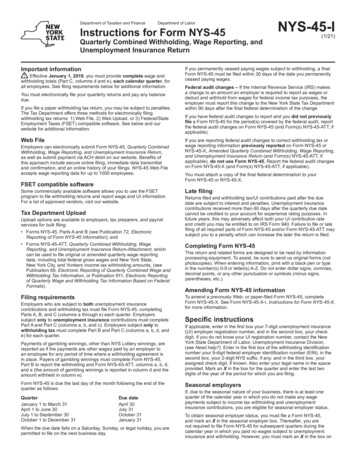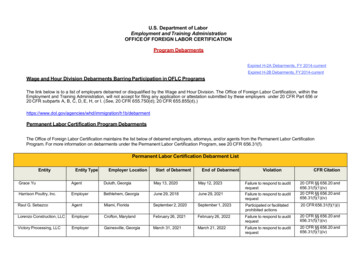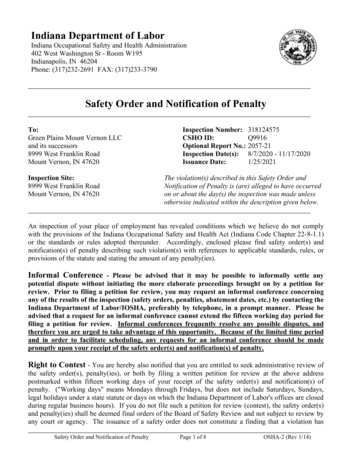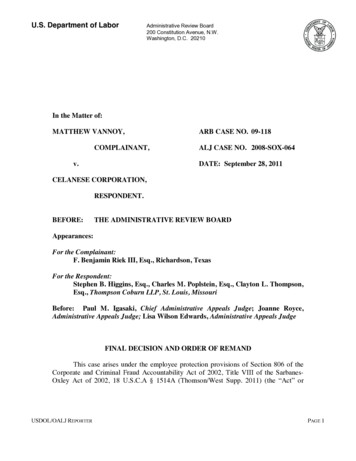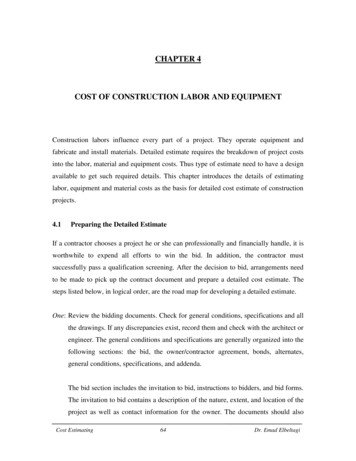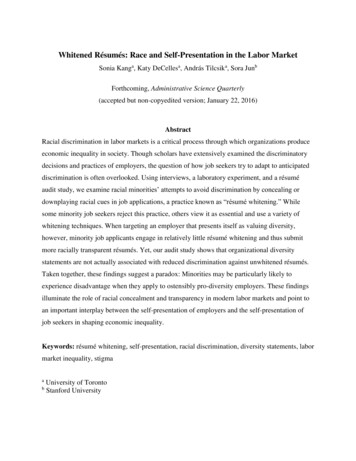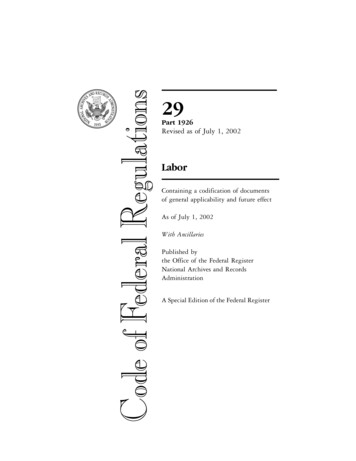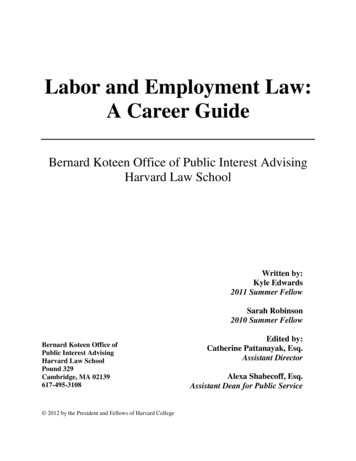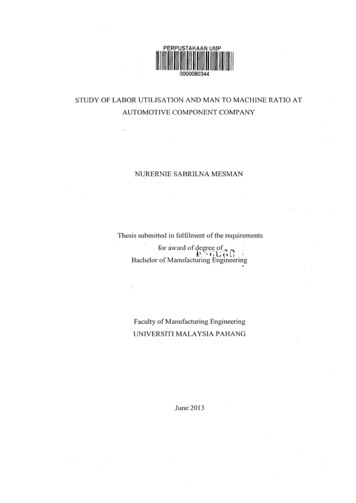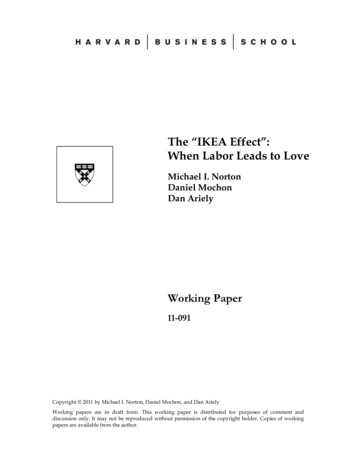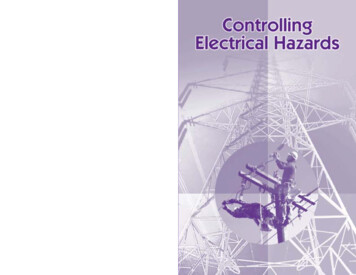
Transcription
U.S. Department of LaborOccupational Safety and Health AdministrationOSHA 30752002 (Revised)
U.S. Department of LaborElaine L. Chao, SecretaryOccupational Safety and Health AdministrationJohn L. Henshaw, Assistant SecretaryOSHA 30752002 (Revised)This booklet provides a generic overview of astandards-related topic. This publication does not alter ordetermine compliance responsibilities, which are describedin the OSHA standards and the Occupational Safetyand Health Act. Because interpretations and enforcementpolicy may change over time, the best sources for additionalguidance on OSHA compliance requirements are currentadministrative interpretations and decisions by theOccupational Safety and Health Review Commission andthe courts. This publication is in the public domain andmay be reproduced fully or partially without permission.Source credit is requested but not required.OSHA will make this information available to sensoryimpaired individuals upon request. Call (202) 693 –1999.The teletypewriter (TTY) number is (877) 889 –5627.To report an emergency, file a complaint, or seek OSHAadvice, assistance, or products, call (800) 321-OSHAor contact your nearest OSHA regional or area office.The teletypewriter (TTY) number is (877) 889-5627.
ContentsIntroduction . 1Why should you be concerned aboutelectrical hazards? . 2What OSHA standards address electrical safety? . 3How do OSHA’s standards minimizeelectrical hazards? . 4Electricity: The Basics . 5What affects the flow of electricity? . 5How does water affect the flow of electricity? . 5What causes shocks? . 5What effect do shocks have on the body? . 6What kind of burns can a shock cause? . 8Why do people sometimes “freeze” whenthey are shocked? . 8What should you do if someone “freezes”to a live electrical contact? . 9How can you tell if a shock is serious? . 9What is the danger of static electricity? . 10Protection Against Electrical Hazards . 11What is the best way to protect yourselfagainst electrical hazards? . 11What protection does insulation provide? . 11How do you identify different types of insulation? . 11What is guarding and what protectiondoes it offer? . 12What is grounding and what protectiondoes it offer? . 13i
What are circuit protection devices andhow do they work? . 14What work practices help protect youagainst electrical hazards? . 15How can you protect yourself againstmetal parts that become energized? . 15How can you prevent an accidental orunexpected equipment startup? . 16How can you protect yourself fromoverhead power lines? . 17What protection does personal equipment offer? . 18What role do tools play? . 18What special training do employees need? . 18What’s the value of a safety and health programin controlling electrical hazards? . 19How Can OSHA Help Me? . 20How does safety and health program managementassistance help employers and employees? . 20What are state plans? . 21How can consultation assistance help employers? . 21Who can get consultation assistanceand what does it cost? . 22Can OSHA assure privacy to an employerwho asks for consultation assistance? . 22Can an employer be cited for violationsafter receiving consultation assistance? . 22Does OSHA provide any incentives forseeking consultation assistance? . 23What is the Voluntary Protection Program? . 23ii
How does the Voluntary Protection Program work? . 24How does VPP help employers and employees? . 24How does OSHA monitor VPP sites? . 25Can OSHA inspect an employer whois participating in the VPP? . 25How can a partnership with OSHA improveworker safety and health? . 25What is OSHA’s Strategic PartnershipProgram (OSPP)? . 26What do OSPPs do? . 26Are there different kinds of OSPPs? . 26What are the benefits of participation inthe OSPP? . 27Does OSHA have occupational safety andhealth training for employers and employees? . 28Does OSHA give money to organizationsfor training and education? . 29Does OSHA have other assistancematerials available? . 30What do I do in case of an emergency?Or if I need to file a complaint? . 30OSHA Offices . 31Regional Offices . 31Area Offices . 33State and Territories withOSHA-Approved Safety and Health Plans . 48OSHA Onsite Consultation Offices . 54iii
IntroductionThis booklet provides an overview of basic electricalsafety on the job.Electricity is essential to modern life, both athome and on the job. Some employees — engineers,electricians, electronic technicians, and power lineworkers, among them — work with electricity directly.Others, such as office workers and sales people, workwith it indirectly. Perhaps because it has become sucha familiar part of our daily life, many of us don’t givemuch thought to how much our work depends on areliable source of electricity. More importantly, wetend to overlook the hazards electricity poses and failto treat it with the respect it deserves.1
Why should you be concernedabout electrical hazards?Electricity has long been recognized as a seriousworkplace hazard, exposing employees to electric shock,electrocution, burns, fires, and explosions. In 1999, forexample, 278 workers died from electrocutions at work,accounting for almost 5 percent of all on-the-job fatalitiesthat year, according to the Bureau of Labor Statistics.What makes these statistics more tragic is that most ofthese fatalities could have been easily avoided.2
What OSHA standardsaddress electrical safety?OSHA standards cover many electrical hazards in manydifferent industries. OSHA’s general industry electricalsafety standards are published in Title 29 Code of FederalRegulations (CFR), Part 1910.302 through 1910.308 —Design Safety Standards for Electrical Systems, and1910.331 through 1910.335 — Electrical Safety-RelatedWork Practices Standards.OSHA’s electrical standards are based on theNational Fire Protection Association Standards NFPA 70,National Electric Code, and NFPA 70E, ElectricalSafety Requirements for Employee Workplaces.OSHA also has electrical safety standards for theconstruction industry, in 29 CFR 1926, Subpart K. OSHA’sstandards for marine terminals, in 29 CFR 1917, and forlongshoring, in 29 CFR 1918, reference the general industryelectrical standards in Subpart S of Part 1910. The shipyardstandards, in 29 CFR 1915, cover limited electrical safetywork practices in 29 CFR 1915.181.Although OSHA operates a federal occupational safetyand health program, 24 states and 2 territories operatetheir own OSHA-approved programs. In those states, thestandards and other procedures governing electrical safetymay not be identical to the federal requirements. They must,however, be at least as effective as the federal standards.3
How do OSHA’s standardsminimize electrical hazards?OSHA standards focus on the design and use of electricalequipment and systems. The standards cover only theexposed or operating elements of an electrical installationsuch as lighting, equipment, motors, machines, appliances,switches, controls, and enclosures, requiring that they beconstructed and installed to minimize workplace electricaldangers. Also, the standards require that certain approvedtesting organizations test and certify electrical equipmentbefore use in the workplace to ensure it is safe.4
Electricity: The BasicsWhat affects the flow of electricity?Electricity flows more easily through some materials thanothers. Some substances such as metals generally offer verylittle resistance to the flow of electric current and are called“conductors.” A common but perhaps overlooked conductoris the surface or subsurface of the earth. Glass, plastic,porcelain, clay, pottery, dry wood, and similar substancesgenerally slow or stop the flow of electricity. They are called“insulators.” Even air, normally an insulator, can become aconductor, as occurs during an arc or lightning stroke.How does water affect theflow of electricity?Pure water is a poor conductor. But small amounts ofimpurities in water like salt, acid, solvents, or other materialscan turn water itself and substances that generally act asinsulators into conductors or better conductors. Dry wood,for example, generally slows or stops the flow of electricity.But when saturated with water, wood turns into a conductor.The same is true of human skin. Dry skin has a fairly highresistance to electric current. But when skin is moist or wet,it acts as a conductor. This means that anyone working withelectricity in a damp or wet environment needs to exerciseextra caution to prevent electrical hazards.What causes shocks?Electricity travels in closed circuits, normally through aconductor. But sometimes a person’s body — an efficientconductor of electricity — mistakenly becomes part of the5
electric circuit. This can cause an electrical shock. Shocksoccur when a person’s body completes the current path with: both wires of an electric circuit; one wire of an energized circuit and the ground; a metal part that accidentally becomes energized due,for example, to a break in its insulation; or another “conductor” that is carrying a current.When a person receives a shock, electricity flows betweenparts of the body or through the body to a ground or theearth.What effect do shocks haveon the body?An electric shock can result in anything from a slighttingling sensation to immediate cardiac arrest. The severitydepends on the following: the amount of current flowing through the body, the current’s path through the body, the length of time the body remains in the circuit, and the current’s frequency.This table shows the general relationship between theamount of current received and the reaction when currentflows from the hand to the foot for just 1 second.6
Effects of Electric Current in the Human BodyCurrentReactionBelow 1 milliampereGenerally not perceptible1 milliampereFaint tingle5 milliamperesSlight shock felt; not painful butdisturbing. Average individual canlet go. Strong involuntary reactionscan lead to other injuries.6–25 milliamperes (women) Painful shock, loss of muscularcontrol*9–30 milliamperes (men)The freezing current or “let-go”range.* Individual cannot let go,but can be thrown away from thecircuit if extensor muscles arestimulated.50–150 milliamperesExtreme pain, respiratory arrest,severe muscular contractions.Death is possible.1,000–4,300 milliamperesRhythmic pumping action ofthe heart ceases. Muscularcontraction and nerve damageoccur; death likely.10,000 milliamperesCardiac arrest, severe burns; deathprobable* If the extensor muscles are excited by the shock, the personmay be thrown away from the power source.Source: W.B. Kouwenhoven, “Human Safety and Electric Shock,”Electrical Safety Practices, Monograph, 112, InstrumentSociety of America, p. 93. November 1968.7
What kind of burns can a shock cause?Burns are the most common shock-related injury.An electrical accident can result in an electrical burn,arc burn, thermal contact burn, or a combination of burns.Electrical burns are among the most serious burns andrequire immediate medical attention. They occur whenelectric current flows through tissues or bone, generatingheat that causes tissue damage.Arc or flash burns result from high temperatures causedby an electric arc or explosion near the body. These burnsshould be treated promptly.Thermal contact burns are caused when the skin toucheshot surfaces of overheated electric conductors, conduits,or other energized equipment. Thermal burns also can becaused when clothing catches on fire, as may occur whenan electric arc is produced.In addition to shock and burn hazards, electricity posesother dangers. For example, arcs that result from shortcircuits can cause injury or start a fire. Extremely high-energyarcs can damage equipment, causing fragmented metal tofly in all directions. Even low-energy arcs can cause violentexplosions in atmospheres that contain flammable gases,vapors, or combustible dusts.Why do people sometimes “freeze”when they are shocked?When a person receives an electrical shock, sometimesthe electrical stimulation causes the muscles to contract.This “freezing” effect makes the person unable to pull freeof the circuit. It is extremely dangerous because
1,000–4,300 milliamperes Rhythmic pumping action of the heart ceases. Muscular contraction and nerve damage occur; death likely. 10,000 milliamperes Cardiac arrest, severe burns; death probable * If the extensor muscles are excited by the shock, the person may be thrown away from the power source.
